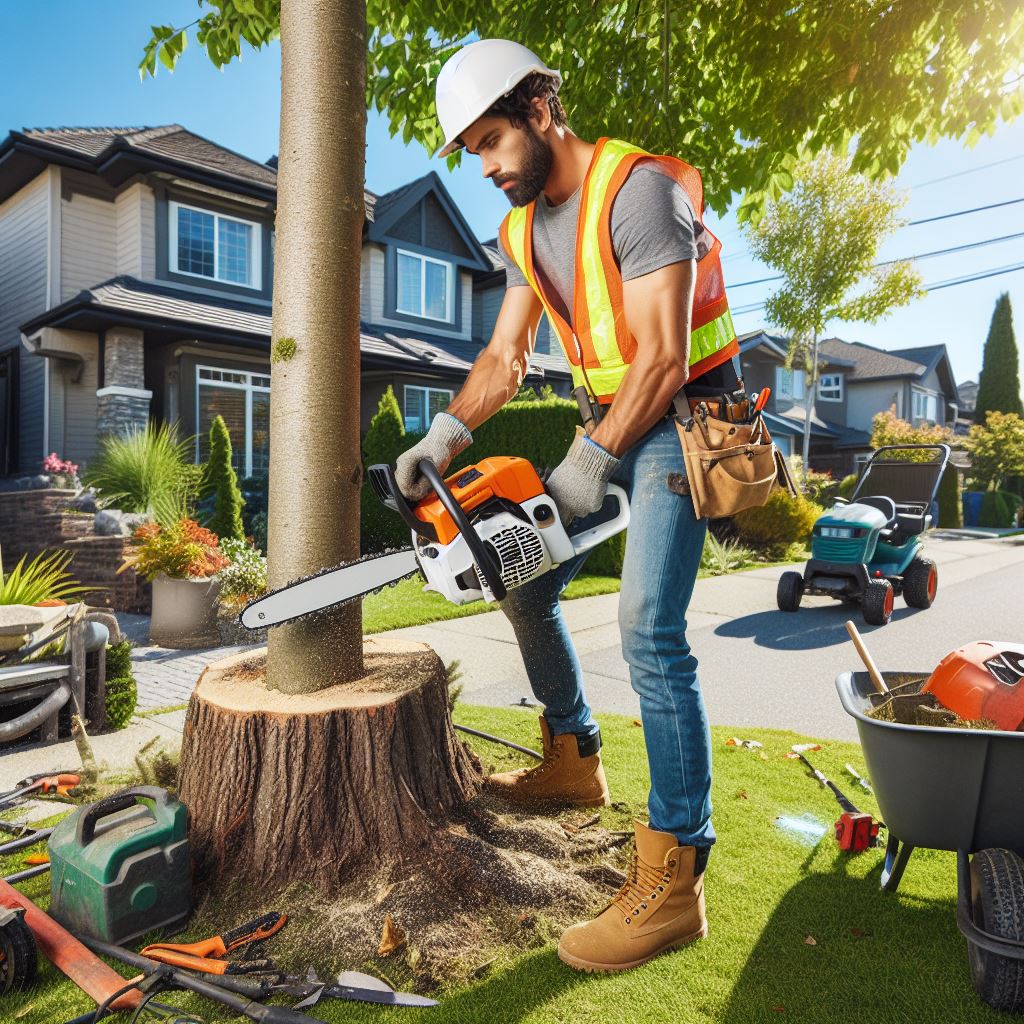Introduction
Landscaping is an art that requires skill, creativity, and the right tools.
Professional landscapers understand the importance of using the right equipment to achieve exceptional results.
In this blog post, we will explore the top 10 landscaping tools that every pro needs.
Importance of using the right tools for professional landscapers
Having the right tools is essential for any job, and landscaping is no exception.
The tools a professional landscaper uses can greatly impact the efficiency and quality of their work.
By investing in high-quality tools, professionals ensure that they can complete projects effectively and efficiently.
The first tool every pro landscaper needs is a reliable lawnmower.
This powerful machine allows them to maintain a neat and well-groomed lawn effortlessly.
A quality pair of pruning shears is another must-have tool that helps trim and shape plants with precision.
Landscapers also rely on a sturdy shovel for various tasks such as digging holes for plants and moving soil.
A hedge trimmer is essential for maintaining beautifully manicured hedges, while a leaf blower helps to keep outdoor spaces clean and tidy.
To enhance their productivity, professional landscapers often use a string trimmer to easily trim grass in hard-to-reach areas.
They also need a durable wheelbarrow for transporting heavy materials such as soil, mulch, or rocks.
Hand trowels and rakes are essential for smaller tasks like planting flowers or raking leaves.
Additionally, a quality chainsaw comes in handy for cutting down trees or trimming branches safely.
Basically, using the right tools is vital for professional landscapers.
They not only make their work easier but also enable them to achieve outstanding results.
By investing in top-notch equipment, landscapers can showcase their skills and create stunning outdoor spaces that their clients will adore.
Essential Power Tools
Top Power Tools Every Pro Landscaper Needs
- Chainsaw
- String trimmer
- Leaf blower
- Lawn mower
- Edger
In order to effectively maintain and enhance landscapes, professional landscapers need to have access to a variety of power tools.
The following are the top power tools that every pro landscaper should have:
Chainsaw
A chainsaw is an essential power tool for any professional landscaper.
It is used for tasks such as cutting down trees, trimming branches, and shaping hedges.
With its powerful motor and sharp cutting chain, a chainsaw makes quick work of even the toughest jobs.
String Trimmer
A string trimmer, also known as a weed eater or weed whacker, is a versatile tool for maintaining the edges of lawns, cutting grass in hard-to-reach areas, and trimming around trees and fences.
It uses a rotating string to cut through vegetation with precision.
Unlock Your Career Potential
Visualize a clear path to success with our tailored Career Consulting service. Personalized insights in just 1-3 days.
Get StartedLeaf Blower
A leaf blower is a powerful tool that helps landscapers keep outdoor spaces clean and tidy.
It can be used to blow away leaves, grass clippings, and other debris from driveways, sidewalks, and lawns.
The blowing force of a leaf blower is adjustable to accommodate different surfaces.
Lawn Mower
No professional landscaper can do without a reliable lawn mower.
It is used to cut grass to a desired height, ensuring a neat and manicured appearance.
Lawn mowers come in various types, including walk-behind and riding mowers, each suitable for different landscape sizes and terrains.
Edger
An edger is a power tool specifically designed to create crisp and clean lines between lawn and paved surfaces.
It is used to give landscapes a polished look by defining edges along sidewalks, driveways, and flower beds.
Edgers come in different styles, such as gas-powered and electric.
Benefits and Specific Uses of Each Power Tool
Each of the power tools mentioned above has its own benefits and specific uses, making them indispensable for every professional landscaper:
A chainsaw provides the ability to handle heavy-duty cutting tasks effortlessly, saving time and effort.
It is ideal for tasks like tree removal, branch trimming, and hedge shaping.
A string trimmer is lightweight and maneuverable, allowing landscapers to reach areas that are difficult to access with a lawn mower.
It is perfect for trimming grass around obstacles like trees, rocks, and fences.
A leaf blower simplifies the process of clearing leaves, grass clippings, and other debris.
Its adjustable blowing force enables efficient cleaning on various surfaces, from lawns to driveways and alleys.
A lawn mower is essential for maintaining a well-groomed lawn.
It helps ensure an even and consistent cut, keeping grass at the desired height and promoting a healthy and attractive appearance.
An edger provides the finishing touch to a landscape by creating clean and defined edges.
It enhances the overall aesthetic appeal and gives the impression of a professionally maintained outdoor space.
Generally, professional landscapers require a set of essential power tools to effectively carry out their tasks.
Chainsaws, string trimmers, leaf blowers, lawn mowers, and edgers are must-have tools with their own benefits and specific uses.
By having these tools at their disposal, pro landscapers can achieve remarkable results and deliver quality services to their clients.
Read: Starting Your Landscaping Business in Canada
Must-Have Hand Tools
Crucial hand tools for professional landscapers
- Shovel: A versatile tool used for digging, lifting, and moving soil or other materials.
- Garden rake: Essential for leveling soil, removing debris, and spreading mulch or gravel evenly.
- Pruning shears: Designed to trim and shape bushes, shrubs, and small branches with precision.
- Hedge trimmers: Perfect for trimming hedges, creating clean lines, and maintaining a neat appearance.
- Wheelbarrow: A heavy-duty cart that helps transport heavy loads of soil, rocks, or plants.
How each hand tool enhances efficiency and precision in landscaping
- Shovel: The shovel’s sturdy blade and long handle allow landscapers to quickly dig holes for planting trees or installing fence posts. It also aids in transferring large amounts of soil or mulch, saving time and effort.
- Garden rake: Landscapers use garden rakes to smooth surfaces, remove weeds, and prepare the soil for planting. Its long handle provides leverage and allows for efficient movement, while the tines help separate debris from the soil effectively.
- Pruning shears: With sharp blades and a compact size, pruning shears make it easy to trim and shape plants precisely. This tool ensures that professional landscapers can maintain the desired appearance and health of various foliage without damaging surrounding areas.
- Hedge trimmers: Hedge trimmers are designed with sharp, serrated blades that effortlessly cut through branches of various thicknesses. By trimming hedges in a uniform manner, these tools contribute to a polished and well-maintained landscape.
- Wheelbarrow: The wheelbarrow’s sturdy construction and large-capacity basin allow landscapers to transport heavy materials like soil, rocks, or plants with ease. This saves time and reduces strain, enhancing productivity on construction or gardening sites.
Essentially, these hand tools are crucial for professional landscapers, providing them with the necessary means to carry out tasks efficiently and with precision.
Whether it’s digging, leveling, trimming, or transporting materials, these tools play a vital role in creating visually appealing and well-maintained landscapes.
Read: Seasonal Landscaping: Tips for Canadian Climates

Specialized Equipment
Few specialized landscaping tools that professionals find useful
- Soil aerator: This tool helps in improving the soil structure by allowing oxygen, water, and nutrients to reach the roots of plants.
- Dethatcher: A crucial tool for removing layers of dead grass, leaves, and debris from the lawn, promoting better growth.
- Chainsaw sharpening kit: Professionals rely on this kit to keep their chainsaw blades sharp, ensuring precise cutting and safety.
- Pole saw: This specialized tool has a long extension pole with a saw attached, enabling professionals to trim or prune tree branches at heights.
Advantages and specific applications of these specialized tools
- Soil aerator: With regular use, it prevents soil compaction, promotes water retention, and enhances nutrient availability, leading to healthier plants and improved root development.
- Dethatcher: Professionals use this tool to remove thatch, which is a layer of decaying organic matter that accumulates between the grass and the soil. By removing thatch, it allows better airflow, water penetration, and nutrient absorption, resulting in a greener and more vibrant lawn.
- Chainsaw sharpening kit: Keeping chainsaw blades sharp ensures efficient cutting, reduces tree damage, and minimizes the risk of accidents. A sharp chainsaw cuts quickly through wood, saving time and effort for professionals.
- Pole saw: This specialized tool helps professionals reach tall branches without needing a ladder, reducing the risk of falls and injuries. It is ideal for pruning, thinning, or removing small branches, enhancing the overall appearance and health of trees.
Advantages
These specialized tools provide professionals with numerous advantages:
- Time-saving: Specialized tools are designed to perform specific tasks efficiently, reducing time spent on manual labor.
- Precision: These tools are specially designed with features that allow for precise and accurate work, ensuring desired results.
- Safety: Specialized tools are equipped with safety features and ergonomic designs that prioritize the user’s safety during operation.
- Enhanced productivity: By using specialized tools, professionals can accomplish tasks more quickly and effectively, increasing their overall productivity.
Specific applications
Specific applications of these tools include:
- Lawn and garden maintenance: Soil aerators are used to improve soil conditions, while dethatchers help in maintaining a healthy and green lawn.
- Tree care and landscaping: Chainsaw sharpening kits are essential for tree pruning, and pole saws are used to reach high tree branches.
In general, specialized equipment is vital for landscaping professionals.
Tools like soil aerators, dethatchers, chainsaw sharpening kits, and pole saws provide numerous advantages in terms of time-saving, precision, safety, and enhanced productivity.
These tools find various applications in lawn and garden maintenance, tree care, and landscaping, contributing to the overall success of professional landscapers.
Read: Eco-Friendly Landscaping Tips in Canada
Importance of Quality and Maintenance
Achieving professional-level landscaping requires more than just skill and expertise.
Investing in high-quality tools and ensuring their proper maintenance are equally important aspects to consider.
In this section, we will emphasize the significance of investing in high-quality tools and discuss the importance of proper tool maintenance for their longevity.
Importance of investing in high-quality tools
When it comes to landscaping, using subpar tools can hinder your productivity and compromise the quality of your work.
Inferior tools not only make tasks more difficult but also result in less satisfactory outcomes.
To truly excel as a professional in the field, it is crucial to invest in high-quality tools.
High-quality tools are designed to withstand the demands of rigorous landscaping work.
Their durability ensures they can handle repetitive use and tough conditions without breaking or requiring frequent replacements.
By investing in quality tools, professionals save both time and money in the long run.
Besides durability, high-quality tools also provide better performance.
With improved features and precision, these tools enable professionals to execute tasks more efficiently.
Whether it’s a lawnmower with a powerful engine or a trimmer with superior cutting ability, quality tools significantly enhance the final results.
Significance of proper tool maintenance to ensure their longevity
While investing in high-quality tools is essential, their longevity largely depends on proper maintenance. Neglecting maintenance can lead to premature deterioration and costly repairs.
To maximize the lifespan of your tools and protect your investment, regular maintenance is vital.
Proper tool maintenance involves a few simple but critical steps.
Firstly, it is important to clean tools after each use, removing dirt, debris, and any moisture that may cause rust or corrosion.
Additionally, sharpening blades and oiling moving parts regularly can significantly extend the life of your tools.
Storing tools correctly is another crucial aspect of maintenance.
Keeping them in a dry, clean, and organized space not only prevents damage but also makes them readily accessible for future use.
Proper storage also reduces the risk of accidents that may occur due to mishandling or improper tool placement.
Tips and best practices for tool maintenance
To ensure your landscaping tools remain in optimal condition, here are some helpful tips for maintenance:
- Always follow the manufacturer’s instructions for maintenance to avoid any potential damage.
- Regularly inspect tools for any signs of wear, damage, or loose parts, and address them promptly.
- Keep tools protected from extreme weather conditions, as excessive heat or cold can impact their performance.
- Use appropriate lubricants and rust inhibitors to prevent corrosion and ensure smooth operation.
- Keep cutting tools sharp and well-maintained for efficient and clean cuts.
- Properly clean and dry tools before storing to prevent rust formation.
- Create a tool maintenance schedule to ensure routine care and prevent neglect.
By following these maintenance practices, professionals can not only extend the lifespan of their tools but also maintain consistent and excellent results in their landscaping projects.
In essence, investing in high-quality landscaping tools and ensuring their proper maintenance are critical for professional landscapers.
High-quality tools enhance productivity, provide better performance, and save money in the long run.
Proper maintenance, including cleaning, sharpening, and correct storage, is essential for maximizing the lifespan and efficiency of the tools.
By adopting good maintenance practices, professionals can continue to deliver exceptional landscaping services and achieve long-term success in their field.
Read: Landscaping 101: A Starter Guide for Canadians
Conclusion
A professional landscaper’s toolkit is essential for ensuring efficient and high-quality work.
In this blog post, we have discussed the top 10 landscaping tools every pro needs.
These tools include a lawn mower, shovel, rake, pruner, edger, wheelbarrow, hose, spade, leaf blower, and hedge trimmer.
Having the right landscaping tools is crucial because they enable professionals to create beautiful outdoor spaces, maintain lawns, trim hedges, and remove debris effectively.
These tools not only save time and effort but also help achieve professional results.
Investing in high-quality tools is a wise decision as they are durable, reliable, and designed to handle the demands of professional landscaping work.
By using the proper tools, professionals can enhance their efficiency, productivity, and customer satisfaction.
In a nutshell, the key points highlighted in this blog post emphasize the importance of having the right landscaping tools for professionals.
With the right tools at hand, landscapers can deliver exceptional results, maintain a competitive edge, and ensure client satisfaction.
So, whether you are a seasoned professional or just starting in the landscaping industry, make sure to equip yourself with these top 10 landscaping tools.
Your toolkit will make all the difference in achieving your desired outcomes and advancing your career as a landscaping professional.




